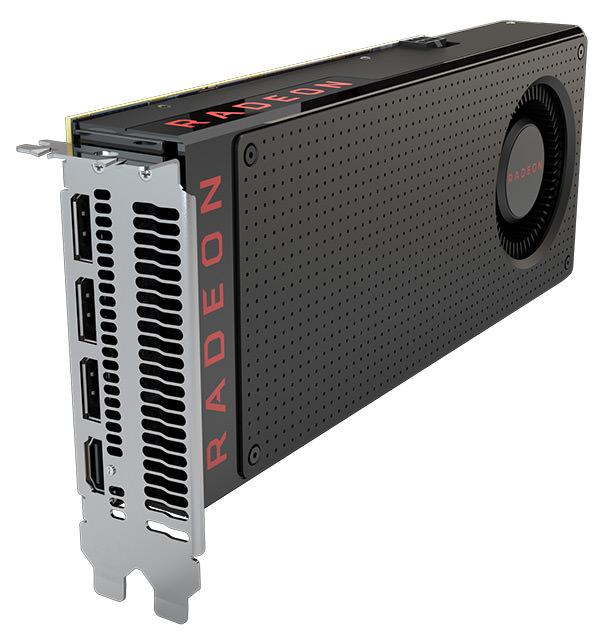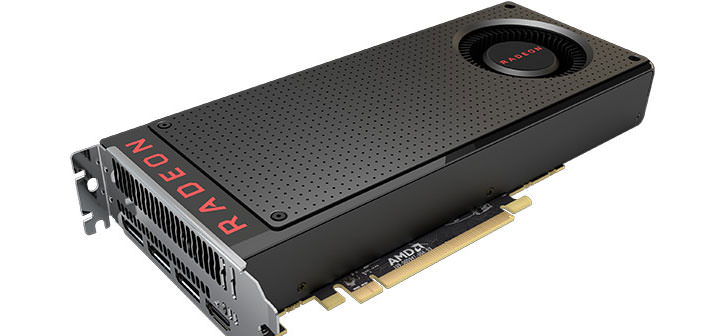Fast graphics for everyone, including the viewers to virtual reality: this is the goal to which he wants to reach AMD presenting the first GPU based card of the Polaris family.
Radeon RX 480 is offered at a price of mid-range and now offers more and higher speed performance with full HD resolution, going even beyond when required.
I spent four weeks by the announcement of AMD focused on the Radeon RX 480 card; we were at Computex Taipei and at that meeting, AMD had communicated the name and price of its raw graphics card intended for the mainstream market segment.
Radeon RX 480, so named altering slightly the approach used until now, by the American company while maintaining the 400 in the acronym that identifies the family of GPUs and that leaves it clear that this is a new-generation product.
And so the rest is, as this board uses the GPU as shown in Polaris code 10 and AMD builds using FinFET production technology to 14 nanometers.
The similarities with the choices that NVIDIA did with your architecture Pascal, used in the GeForce 1080 GTX and GeForce 1070 GTX solutions may seem numerous, but they are very few.
NVIDIA produces these chips with 16-nanometer FinFET at the historic TSMC partners, while AMD has chosen in this case to develop the new GPU together with Global Foundries.
The differences in terms of production technology, 14nm to 16nm for AMD and NVIDIA, should not deceive us: at this level the indication of the minimum transistor size is the result of the type of metrics that are chosen, often slightly different from a production foundry to other.
Suffice it so say that the next generation GPUs from AMD and NVIDIA are both built using the most sophisticated production technologies now available to these two companies, a development that has long been expected after the GPU in recent years had all been developed keeping faithful the process to 28 nanometers.
Comparable production process, but the basic choices very different. If the GP104 GPU, the first incarnation of architecture NVIDIA Pascal destined to desktop video cards for gamers, it is designed for medium to high-end cards with Polaris 10 and 480 AMD Radeon RX tip sheet on the mainstream segment, with a price level well different from that of the GeForce 1080 GTX and GeForce 1070 GTX.
 And of US $ 199, the official list announced by AMD at the time of the presentation of this card, a figure that surprised both the sector as many people in the same AMD as unexpected. Generally, we expect a top of the range proposed in the debut of a new generation of architecture: with Polaris AMD has instead played the card of the mainstream market, one that sees the rest of the majority of gamers to navigate the well-known budget limits available, postponing the coming months the launch of the top-end solutions.
And of US $ 199, the official list announced by AMD at the time of the presentation of this card, a figure that surprised both the sector as many people in the same AMD as unexpected. Generally, we expect a top of the range proposed in the debut of a new generation of architecture: with Polaris AMD has instead played the card of the mainstream market, one that sees the rest of the majority of gamers to navigate the well-known budget limits available, postponing the coming months the launch of the top-end solutions.
AMD then abandons the high end of the market range of video cards? The answer is certainly negative: early next year AMD will present the new generation of video cards based on GPU Vega, changing top of the range of the Polaris combined for the first time in technology HBM second generation for video memory.
Let’s see in detail the current proposal for AMD in the desktop graphics card market segment:
- Radeon RX 480 is the video card that is on the market today, GPU-based Polaris 10 in implementation with all 36 CU enabled as standard. This product is designed by AMD to users who are looking for a solution capable of providing high playability to Full HD resolution and up as well as to manage a viewer for virtual reality.
- Radeon RX 470 : second solution based on GPU Polaris 10, in this case in the implementation with 32 CU enabled. The target audience is the enthusiast user searching for a card with which to ensure a continued high frames per second at full HD resolution.
- Radeon RX 460 : it is the entry card, GPU-based Polaris 11 and for the public gamer who delights in so-called e-sports titles.
If the AMD Radeon RX 480 card has made available for all the full specifications, so it is not for the other two cards that will be officially introduced to the market. In the following table, we have summarized the data provided by AMD:
| CPU | Radeon RX 480 | Radeon RX 470 | Radeon RX 460 |
| GPU | Polaris 10 | Polaris 10 | Polaris 11 |
| Architecture | GCN 1.4 | GCN 1.4 | GCN 1.4 |
| CU | 36 | 32 | 14 |
| TFLOPS | > 5 | > 4 | > 2 |
| Memory bandwidth | 224/256 GB/s | – | – |
| Memory bus | 256 bit | 256 bit | 128 bit |
| Amount of memory | 4-8 GB | 4 GB | 2 GB |
| Type memory | GDDR5 | GDDR5 | GDDR5 |
| Supply | 1x6pin | 1x6pin | No |
| Display Port | 1.3 / 1.4 HDR | 1.3 / 1.4 HDR | 1.3 / 1.4 HDR |
| Power | 150 Watt | – | – |
For the two proposals Radeon RX 470 and Radeon RX 460 lack specific information related to the card’s consumption and bandwidth of video memory, while the indication of the GPU processing power used is provided in terms of TFLOPS.
The reference board developed by AMD Radeon RX480 has a very simple construction, which conceals the very small overall size of the PCB. The overall dimensions in length, small is due to the cooling system and not to the video card as can easily be seen by observing the rear.
AMD has opted for a blower type fan that draws air from the inside of blowing it houses along the fins of the cooler so that is exhausted to the outside from the system through the rear grill.
This is the same type of design adopted by NVIDIA for the GeForce GTX 1080 and GeForce GTX 1070 cards in Founders Edition, and we believe that many partners will choose to implement for some of the Radeon RX 480 cards. Others will opt instead to develop customized versions, standard and overclocked characterized by the use of cooling systems specially developed.
Product prices and availability are subject to change. Any price and availablility information displayed on Amazon at the time of purchase will apply to the purchase of any products.
Conclusions
The rear panel features HDMI and Display Port, for which AMD connections provided for the implementation of the latest technologies in the field: the Display Port support comes to standard 1.3/1.4 HDR, while the HDMI connector is 2.0. This choice will be shared with the other tabs in the Polaris family, wanting to confirm the AMD reference to ensuring full compatibility with next-generation displays that are debuting on the market characterized by 4K resolution and beyond as well as support to HDR technology.
- Overall


